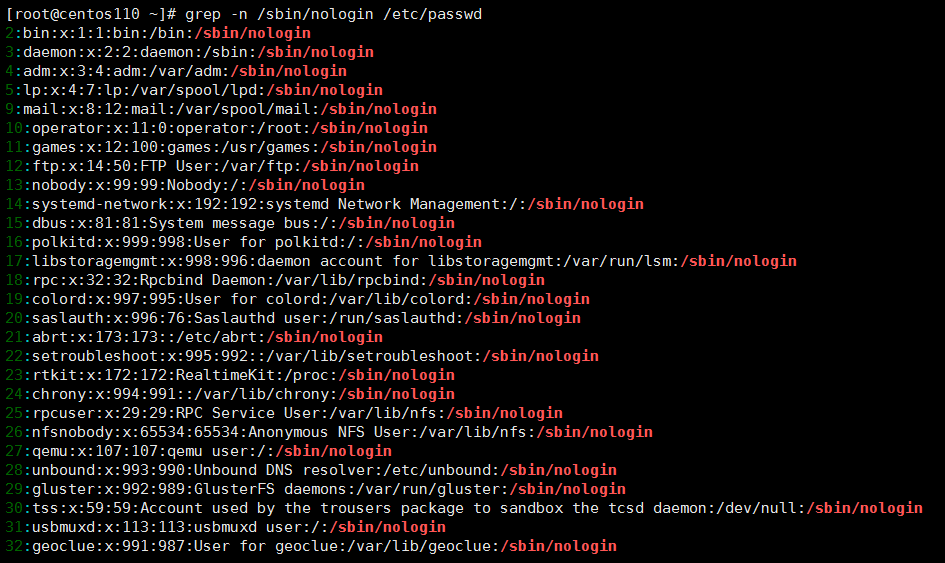2018-10-03 22:20:48
一、文件目录管理命令
1、touch 命令
用于创建空白文件或设置文件的时间,格式为“touch [选项] [文件]”。
参数:
-a :仅修改“读取时间(atime)”
-m:仅修改“修改时间(mtime)”
-d:同时修改 atime 与 mtime
2、mkdir 命令
用于创建空白的目录,格式为“mkdir [选项] 目录”。
mkdir -p:递归创建具有嵌套叠层关系的文件目录
[root@centos110 ~]# mkdir linuxprobe
[root@centos110 ~]# cd linuxprobe
[root@centos110 linuxprobe]# mkdir -p a/b/c/d/e
[root@centos110 linuxprobe]# tree
.
└── a
└── b
└── c
└── d
└── e
5 directories, 0 files
3、cp 命令
用于复制文件或目录,格式为“cp [选项] 源文件 目标文件”。
Linux系统中,复制操作具体分为3种情况:
(1)如果目标文件是目录,则会把源文件复制到该目录中;
(2)如果目标文件也是普通文件,则会询问是否要覆盖它;
(3)如果目标文件不存在,则执行正常的复制操作;
参数:
-p :保留原始文件的属性
-d:若对象为“链接文件”,则保留该“链接文件”的属性
-r:递归持续复制(用于目录)
-i:若目标文件存在则询问是否覆盖
-a:相当于-pdr(p、d、r 为上述参数)
4、mv 命令
用于剪切文件或者将文件重命名,格式为“mv [选项] 源文件 [目标路径 | 目标文件名]”。
5、rm 命令
用于删除文件或目录,格式为“rm [选项] 文件”。
rm -f:不询问,直接删除
rm -r:删除目录
6、dd 命令 (重点)
用于按照指定大小和个数的数据块来复制文件或转换文件,格式为“dd [参数]”。
设备文件 /dev/zero,不会占用系统存储空间,却可以提供无穷无尽的数据;
因此可以使用它作为dd命令的输入文件,来生成一个指定大小的文件。
dd命令参数:
if:输入的文件名
of:输出的文件名
bs:设置每个“块”的大小
count:设置要复制“块”的个数
例:用 dd命令 从 /dev/zero 设备文件中取出一个大小为560M的数据块,然后保存成名为 560_file 的文件:
1 [root@centos110 ~]# dd if=/dev/zero of=560_file count=1 bs=560M
2 1+0 records in
3 1+0 records out
4 587202560 bytes (587 MB) copied, 62.0188 s, 9.5 MB/s
7、file 命令
用于查看文件的类型,格式为“file 文件名”。
1 [root@centos110 ~]# file anaconda-ks.cfg
2 anaconda-ks.cfg: ASCII text
3 [root@centos110 ~]# file /dev/sda
4 /dev/sda: block special
二、打包压缩与搜索命令
1、tar 命令
用于对文件进行打包压缩或解压,格式为“tar [选项] [文件] ”。
1 -c:创建压缩文件
2 -x:解开压缩文件
3 -t:查看压缩包内有哪些文件
4 -z:用Gzip压缩或解压,后缀.gz
5 -j:用bzip2压缩或解压,后缀.bz2
6 -J:创建.tar.xz包,后缀.xz
7 -v:显示压缩或解压过程
8 -f:目标文件名 #特别重要,必须放在参数的最后一位
9 -p:保留原始的权限与属性
10 -P:使用绝对路径来压缩(大写P)
11 -C:指定解压到的目录
1 打包文件: # tar [参数] 新建文件名 源文件路径
2 [root@centos110 ~]# tar -cvf grub2.tar /boot/grub2
3 tar: Removing leading `/' from member names
4 /boot/grub2/
5 /boot/grub2/device.map
6 /boot/grub2/i386-pc/
7 ......
8
9 解包文件: # tar [参数] 包文件名
10 [root@centos110 ~]# tar -xvf grub2.tar
11 boot/grub2/
12 boot/grub2/device.map
13 boot/grub2/i386-pc/
14 boot/grub2/i386-pc/gcry_rmd160.mod
15 ......
# 创建.tar.gz包
1 [root@centos110 ~]# tar -zcvf etc.tar.gz /etc #归档并压缩目录/etc
2 tar: Removing leading `/' from member names
3 ......
4 [root@centos110 ~]# tar -zxvf etc.tar.gz -C /opt #解压缩,并指定解压到/opt目录
5 ......
6 [root@centos110 ~]# ls /opt
7 a.sh bak.sh case-if.sh etc for-1.sh rh root.tar.gz sh-1.sh test-1.sh
# 创建.tar.bz2包
1 [root@centos110 ~]# tar -jcvf etc.tar.bz2 /etc > /dev/null #归档并压缩目录/etc
2 tar: Removing leading `/' from member names
3 ......
4 [root@centos110 ~]# tar -jxvf etc.tar.bz2 -C /opt > /dev/null #解压并指定解压到/opt目录
5 [root@centos110 ~]# ls /opt
6 a.sh bak.sh case-if.sh etc for-1.sh rh root.tar.gz sh-1.sh test-1.sh
# 创建.tar.xz包
1 [root@centos110 ~]# tar -Jcvf etc.tar.xz /etc
2 ......
3 [root@centos110 ~]# tar -xvf etc.tar.xz
2、grep 命令
用于在文本中执行关键词搜索,并显示匹配的结果,格式为“grep [选项] [文件]”。
#grep 命令参数:
1 -b:将可执行文件(binary)当做文本文件(text)来搜索 2 -c:仅显示找到的行数 3 -i:忽略大小写
# 最常用的两个参数,几乎能完成日后80%的工作需要 4 -n:显示行号 5 -v:反向选择—仅列出没有“关键词”的行
示例:使用grep 命令查找当前系统中不允许登录系统的所有用户信息:
#grep -n /sbin/nologin /etc/passwd

3、find 命令
用于按照指定条件来查找文件,格式为“find [查找路径] 寻找条件 操作”。
# find 命令参数及其作用
1 -name #匹配名称
2 -perm #匹配权限(mode为完全匹配,-mode为包含即可)
3 -user #匹配所有者
4 -group #匹配所有组
5 -mtime -n +n #匹配修改内容的时间(-n指 n 天以内,+n 指 n 天以前)
6 -atime -n +n #匹配访问文件的时间(-n指 n 天以内,+n 指 n 天以前)
7 -ctime -n +n #匹配修改文件权限的时间(-n指 n 天以内,+n 指 n 天以前)
8 -nouser #匹配无所有字的文件
9 -nogroup #匹配无所有组的文件
10 -newer f1 !f2 #匹配比文件f1新但比f2旧的文件
11 --type b/d/c/p/l/f #匹配文件类型(后面的字符参数依次表示块设备、目录、字符设备、管道、链接文件、文本文件)
12 -size #匹配文件的大小(+50KB为查找超过50KB的文件,而-50KB为查找小于50KB的文件)
13 -prune #忽略某个目录
14 -exec ......{} #后面可跟用于进一步处理搜索结果的命令
# 获取/etc目录中所有以host开头的文件列表
1 [root@centos110 ~]# find /etc -name "host*"
2 /etc/host.conf
3 /etc/hosts
4 /etc/hosts.allow
5 /etc/hosts.deny
# 在这个系统中搜索权限中包括SUID权限的所有文件
1 [root@centos110 ~]# find / -perm -4000
2 find: ‘/proc/42469/task/42469/fd/5’: No such file or directory
3 find: ‘/proc/42469/task/42469/fdinfo/5’: No such file or directory
4 find: ‘/proc/42469/fd/6’: No such file or directory
5 find: ‘/proc/42469/fdinfo/6’: No such file or directory
6 /usr/bin/fusermount
7 /usr/bin/passwd
8 /usr/bin/chfn
9 /usr/bin/chsh
10 /usr/bin/chage
11 /usr/bin/gpasswd
12 /usr/bin/newgrp
13 /usr/bin/staprun
14 /usr/bin/crontab
......
# 在整个文件系统中找出所有归属于md用户的文件并复制到 /root/findresults 目录下
# 该示例的重点是“-exec {} ;”参数,其中的{}表示 find 命令搜索出的每一个文件,并且命令的结尾必须是“;”
1 [root@centos110 ~]# mkdir /root/findresults
2 [root@centos110 ~]# find / -user md -exec cp -a {} /root/findresults/ ;
3 find: ‘/proc/42909/task/42909/fd/5’: No such file or directory
4 find: ‘/proc/42909/task/42909/fdinfo/5’: No such file or directory
5 find: ‘/proc/42909/fd/6’: No such file or directory
6 find: ‘/proc/42909/fdinfo/6’: No such file or directory
7 cp: ‘/root/findresults/md’ and ‘/root/findresults/md’ are the same file
8 cp: cannot overwrite non-directory ‘/root/findresults/md’ with directory ‘/home/md’
9 [root@centos110 ~]# ls /root/findresults
10 2041 gdm parser-sha1.txt
11 3.22 gnome-initial-setup-done photos
12 abrt gnome.json Pictures
......省略输出内容......